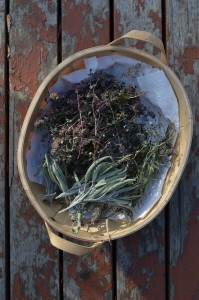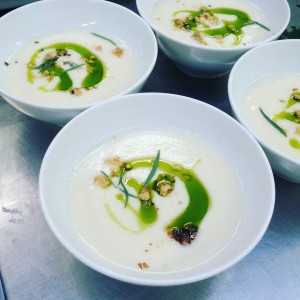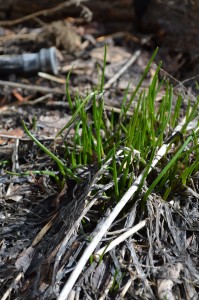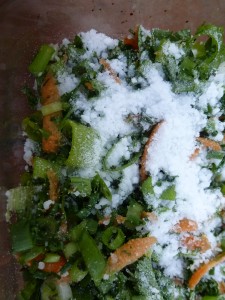Many years ago I posted about my default herb oil procedure, which I learned from The French Laundry Cookbook. In a nutshell:
- blanche herbs,
- shock in ice water,
- ring out as much moisture as possible,
- purée in a powerful blender with oil,
- let stand overnight (optional, but recommended),
- strain through a coffee filter.
Most of the herb oil recipes in The French Laundry Cookbook call for 4 cups of fresh herbs and 3/4 cup oil to yield only 1/3 cup herb oil.
I have sworn by this procedure for years. However recently I was reading the “Oils and Dressings” section at the back of the Eleven Madison Park cookbook, and while the Tarragon Oil follows the same … Continue reading.
 “Fresh is best.”
“Fresh is best.”
Armed with this maxim many chefs spurn dried herbs. I’d like to go to bat for dried herbs. Not the dried herbs that have been in your pantry since Harper took office, and certainly not the dried powdered herbs you buy in one pound bags from a bulk store, but the dried herbs that you make from the plethora of fresh herbs you have languishing in your autumn backyard.
I take for granted that you have a plethora of fresh herbs languishing in your autumn backyard.
You should, because it’s important to use lots of herbs in cooking, and paying $4 for a 28 g packet at the grocery store is crazy. You can buy an entire … Continue reading.
Last night I ate out at an Italian restaurant, one of them new-fangled Italian joints that have hardly any tomato sauce on the menu, and nary a checkered table-cloth or plastic grape vine in sight. I had a bowl of squash tortelloni with brown butter and sage, a classic dish from the hallowed kitchens of Emilia-Romagna. The sage was raw.
People usually freak out over raw chicken, not raw herbs, but eating those fuzzy, grey, acrid sage leaves was at least as unpleasant as contracting salmonella.
Chefs distinguish between fine herbs and resinous herbs. Fine herbs are delicate and usually eaten raw. Examples are basil, parsley, chervil, and tarragon. Resinous herbs are more robust and are usually cooked. Examples are … Continue reading.
 Herb oil is a powerful tool to have in your culinary belt.
Herb oil is a powerful tool to have in your culinary belt.
It is a fantastic way to preserve a glut of herbs, especially a glut of herbs that are past their prime, for instance basil that is starting to get moist and speckled. This less-than-attractive basil still has loads of flavour. And parts of the herb that are usually discarded, say the thick, woody stem of a basil plant, are also full of flavour, and make great herb oil. Herb oil keeps for weeks in the fridge and months in the freezer, and if made properly it is a stunning, concentrated, lustrous, fluid version of the plant it is made from.
My herb oil process is ripped directly from … Continue reading.
 Chives are prized for their pure allium flavour, blessedly devoid of the harsh burn of raw onion.
Chives are prized for their pure allium flavour, blessedly devoid of the harsh burn of raw onion.
Here are some other awesome things about chives.
They are hearty perennials, which means they re-appear every spring and require very little attention. In fact, they grow as weeds in many parts of Edmonton, including downtown parking lots. I don’t mean that you should harvest them from downtown parking lots; I just offer that as evidence of their gumption.
They are one of the first edibles to appear in spring. This year the spring thaw came early, and my chives were a few inches tall by the end of March. It was seeing this enterprising green growth that inspired me to … Continue reading.
Resinous herbs can easily handle lights frosts, so this time of year we still have a good deal of thyme, rosemary, and other robust herbs in the garden. Thankfully there is an entire repertoire of methods to preserve them before the snow falls. You can collect them in large bouquets and hang them in your kitchen to dry, for instance. Or make salted herbs. Or pack them into a jar and pour vinegar over them. This past week I racked a couple gallons of cider vinegar from a healthy vinegar crock, so herb vinegar seemed the best way to save our thyme.
The aromatic components of herbs are called essential oils. They more closely resemble fats, ethanol, and … Continue reading.
 This is a very old-school Québécois way to preserve herbs, onions, carrots… really any manner of aromatic vegetable. They are chopped finely, mixed with salt, left in the fridge for a week, then transferred to a jar. That’s it.
This is a very old-school Québécois way to preserve herbs, onions, carrots… really any manner of aromatic vegetable. They are chopped finely, mixed with salt, left in the fridge for a week, then transferred to a jar. That’s it.
Ingredients. It would be silly to offer a “recipe” as such for herbes salées. You shouldn’t go to a grocery store and buy a set of ingredients; you should use whatever you have in abundance in your herb garden in the late season. There are, however, some useful ratios to keep in mind.
1 part salt for every 3 parts aromatics, by weight. In other words 33 g of salt for every 100 g of herb mix.
In terms … Continue reading.
The personal website of Edmonton chef Allan Suddaby


 Herb oil is a powerful tool to have in your culinary belt.
Herb oil is a powerful tool to have in your culinary belt.
 This is a very old-school Québécois way to preserve herbs, onions, carrots… really any manner of aromatic vegetable. They are chopped finely, mixed with salt, left in the fridge for a week, then transferred to a jar. That’s it.
This is a very old-school Québécois way to preserve herbs, onions, carrots… really any manner of aromatic vegetable. They are chopped finely, mixed with salt, left in the fridge for a week, then transferred to a jar. That’s it.